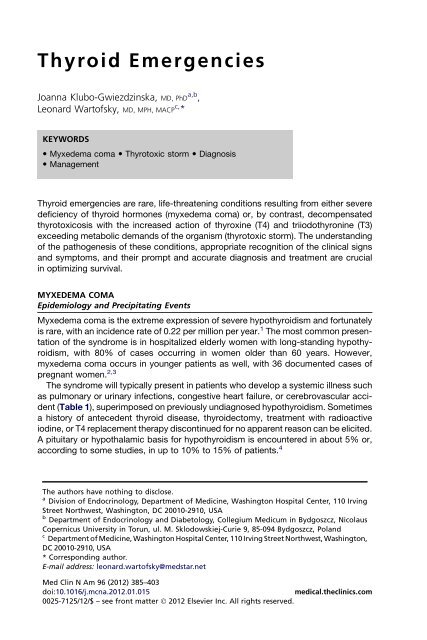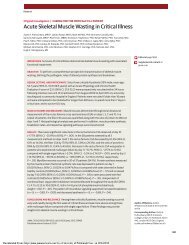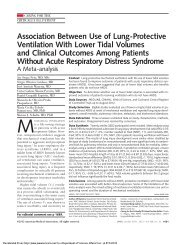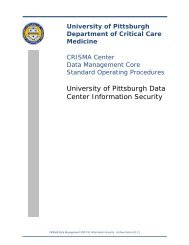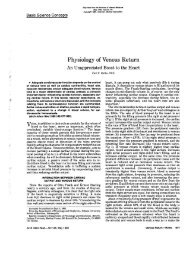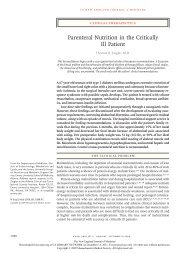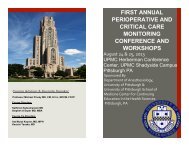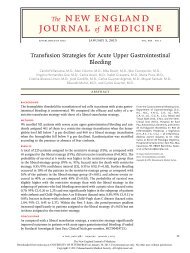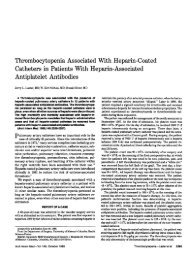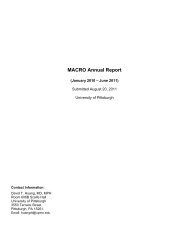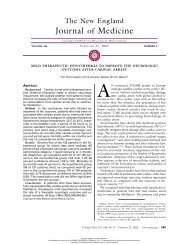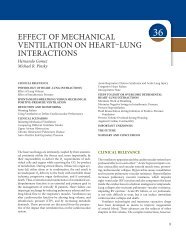Thyroid Emergencies - Department of Critical Care Medicine
Thyroid Emergencies - Department of Critical Care Medicine
Thyroid Emergencies - Department of Critical Care Medicine
You also want an ePaper? Increase the reach of your titles
YUMPU automatically turns print PDFs into web optimized ePapers that Google loves.
386Klubo-Gwiezdzinska & Wart<strong>of</strong>skyTable 1Factors precipitating thyroid emergencies: myxedema coma and thyrotoxic stormMyxedema ComaDrugsWithdrawal <strong>of</strong> L-thyroxineAnestheticsSedativesTranquilizersNarcoticsAmiodaroneLithium carbonateInfections, sepsisCerebrovascular accidentsCongestive heart failureLow temperaturesTraumaMetabolic disturbancesAcidosisHypoglycemiaHyponatremiaHypercapniaOtherGastrointestinal bleedingIngestion <strong>of</strong> raw bok choyPrecipitating FactorsThyrotoxic StormDrugsWithdrawal <strong>of</strong> antithyroid drug treatmentRadioactive iodine treatmentThyroxine/triiodothyronine overdosageCytotoxic chemotherapyAspirin overdosageIodinated contrast dyesOrganophosphatesSepsis, infectionSeizure disorderPulmonary thromboembolismBurn injurySurgery, trauma, vigorous palpation <strong>of</strong> thyroidMetabolic disturbancesDiabetic ketoacidosisHypoglycemiaOtherParturitionEmotional stressPatients with myxedema coma generally present in the winter months, suggestingthat external cold may be an aggravating factor. 5 Some abnormalities such as hypoglycemia,hypercalcemia, hyponatremia, hypercapnia, and hypoxemia, may be eitherprecipitating factors or secondary consequences <strong>of</strong> myxedema coma. Moreover, thecomatose state is associated with the risk <strong>of</strong> aspiration pneumonia and sepsis. Inhospitalized patients, drugs such as anesthetics, narcotics, sedatives, antidepressants,and tranquilizers may depress respiratory drive and thereby either cause orcompound the deterioration <strong>of</strong> the hypothyroid patient into coma. 6,7 The effect <strong>of</strong>these drugs should be taken into consideration as a potential causative mechanism.In fact, Church and Callen 8 described a 41-year-old male patient without any history<strong>of</strong> thyroid disease who developed myxedema coma after being administered combinedtherapy with aripiprazole and sertraline.There is also a report <strong>of</strong> myxedema coma induced by chronic ingestion <strong>of</strong> largeamounts <strong>of</strong> raw bok choy. This Chinese white cabbage contains glucosinolates, whichbreak down products such as thiocyanates, nitriles, and oxazolidines, and inhibitiodine uptake and production <strong>of</strong> thyroid hormones by the thyroid gland. When eatenraw, digestion <strong>of</strong> the vegetable releases the enzyme myrosinase, which acceleratesproduction <strong>of</strong> the aforementioned thyroid disruptors. 9Clinical Signs and SymptomsHypothermia (<strong>of</strong>ten pr<strong>of</strong>ound to 80 F [26.7 C]) and unconsciousness constitute 2 <strong>of</strong>the cardinal features <strong>of</strong> myxedema coma. 10 Of importance is that coincident infectionmay be masked by hypothyroidism, with a patient presenting as afebrile despite anunderlying severe infection. In view <strong>of</strong> the latter and the fact that undiagnosed infection
<strong>Thyroid</strong> <strong>Emergencies</strong> 387might lead inexorably to vascular collapse and death, some authorities have advocatedthe routine use <strong>of</strong> antibiotics in patients with myxedema coma. Underlyinghypoglycemia may further compound the decrement in body temperature.Although coma is the predominant clinical presentation, a history <strong>of</strong> disorientation,depression, paranoia, or hallucinations (myxedema madness) may <strong>of</strong>ten be elicited.The neurologic findings may also include cerebellar signs (poorly coordinatedpurposeful movements <strong>of</strong> the hands and feet, ataxia, adiadochokinesia), poor memoryand recall, or even frank amnesia, and abnormal findings on electroencephalography(low amplitude and a decreased rate <strong>of</strong> a-wave activity). Status epilepticus has beenalso described 11 and up to 25% <strong>of</strong> patients may experience seizures possibly relatedto hyponatremia, hypoglycemia, or hypoxemia.Respiratory SystemThe mechanism for hypoventilation in pr<strong>of</strong>ound myxedema is a combination <strong>of</strong>a depressed hypoxic respiratory drive and a depressed ventilatory response to hypercapnia.12,13 Partial obstruction <strong>of</strong> the upper airway caused by edema <strong>of</strong> the tongue orvocal cords may also play a role. Hypothyroid patients may be predisposed toincreased airway hyperresponsiveness and chronic inflammation. 14 Tidal volumemay be additionally reduced by other factors such as pleural effusion or ascites. toachieve appropriately effective pulmonary function in myxedema coma, prolongedmechanically assisted ventilation is usually required.Cardiovascular ManifestationsPatients diagnosed with myxedema coma are at increased risk for shock and potentiallyfatal arrhythmias. Typical electrocardiographic (ECG) findings includebradycardia, varying degrees <strong>of</strong> block, low voltage, flattened or inverted T waves,and prolonged Q-T interval, which can result in torsades de pointes ventricular tachycardia.15 Myocardial infarction should also be ruled out by the usual diagnostic procedures,because aggressive or injudicious T4 replacement may increase the risk <strong>of</strong>myocardial infarction. Moreover, cardiac contractility is impaired, leading to reducedstroke volume and cardiac output. Reduced stroke volume in severe cases may alsobe due to the cardiac tamponade caused by the accumulation <strong>of</strong> fluid rich in mucopolysaccharideswithin the pericardial sac.Electrolyte Disturbances and Renal ManifestationsHyponatremia is a common finding observed in patients with myxedema coma. Themechanism accounting for the hyponatremia is associated with increased serum antidiuretichormone 16 and impaired water diuresis caused by reduced delivery <strong>of</strong> waterto the distal nephron. 17 Depending on its duration and severity, hyponatremia will addto altered mental status, and when severe may be largely responsible for precipitatingthe comatose state. Alterations in renal function observed in myxedema coma includedecreases in glomerular filtration rate and renal plasma flow, and increases in totalbody water. Atony <strong>of</strong> the urinary bladder with retention <strong>of</strong> large residual urine volumesis commonly seen. Renal failure may occur as a result <strong>of</strong> underlying rhabdomyolysiswith extremely high levels <strong>of</strong> creatine kinase. 18–21Gastrointestinal ManifestationsThe gastrointestinal tract in myxedema may be marked by mucopolysaccharide infiltrationand edema <strong>of</strong> the muscularis, as well as neuropathic changes leading to gastricatony, impaired peristalsis, and even paralytic ileus. Ascites may occur, and has beendocumented in one report <strong>of</strong> 51 cases. 22 Another potential complication is
388Klubo-Gwiezdzinska & Wart<strong>of</strong>skygastrointestinal bleeding secondary to an associated coagulopathy. 23 It is importantto recognize the underlying mechanisms <strong>of</strong> these acute gastrointestinal complicationsso as to avoid unnecessary surgery for an apparent acute abdomen. 24Hematological ManifestationsIn contrast to the tendency to thrombosis seen in mild hypothyroidism, severe hypothyroidismis associated with a higher risk <strong>of</strong> bleeding caused by coagulopathy relatedto an acquired von Willebrand syndrome (type 1) and decreases in factors V, VII, VIII,IX, and X. 25 The von Willebrand syndrome is reversible with T4 therapy. 26 Anothercause <strong>of</strong> bleeding may be disseminated intravascular coagulation associated withsepsis. Patients with myxedema coma have increased preponderance to severe infections,including sepsis, because <strong>of</strong> granulocytopenia and a decreased cell-mediatedimmunologic response. Such patients may also present with a microcytic anemiasecondary to hemorrhage, or a macrocytic anemia caused by vitamin B 12 deficiency,which may also worsen the neurologic state.DiagnosisTo summarize the aforementioned clinical manifestations, the typical patient presentingwith myxedema coma is a woman in the later decades <strong>of</strong> life who may havea history <strong>of</strong> thyroid disease and who is admitted to hospital, typically in winter, withpneumonia. Physical findings could include bradycardia, macroglossia, hoarseness,delayed reflexes, dry skin, general cachexia, hypoventilation, and hypothermia,commonly without shivering. Laboratory evaluation may indicate hypoxemia, hypercapnia,anemia, hyponatremia, hypercholesterolemia, and increased serum lactatedehydrogenase and creatine kinase. On lumbar puncture there is increased pressureand the cerebrospinal fluid has high protein content.Although an elevated serum thyrotropin (TSH) concentration is the most importantlaboratory evidence for the diagnosis, the presence <strong>of</strong> severe complicating systemicillness or treatment with drugs such as dopamine, dobutamine, or corticosteroids mayserve to reduce the elevation in TSH levels. 27,28 There may also be a pituitary cause forthe hypothyroidism, in which case an increased TSH would not be found.TreatmentMyxedema coma as a true medical emergency requires a multifaceted approach totreatment in a critical care setting.Airways and ventilationThe patient’s comatose state is perpetuated by hypoventilation, with CO 2 retentionand respiratory acidosis. The maintenance <strong>of</strong> an adequate airway is the single mostimportant supportive measure, because <strong>of</strong> the high mortality rate associated withthe inexorable respiratory failure. Mechanical ventilation is usually required duringthe first 36 to 48 hours, but in some patients it may be necessary to continue assistedventilation for as long as 2 to 3 weeks. The hypercapnia may be rapidly relieved withmechanical ventilation, but the hypoxia tends to persist, possibly because <strong>of</strong> shuntingin nonaerated lung areas. 29 It is advisable, therefore, not to extubate the patientsprematurely and to wait until full consciousness is attained.<strong>Thyroid</strong> hormone therapyOne <strong>of</strong> the most controversial aspects <strong>of</strong> the management <strong>of</strong> myxedema coma is whichthyroid hormone preparation to give and how to give it (dose, frequency, and route <strong>of</strong>administration). The optimum treatment remains uncertain, because <strong>of</strong> the scarcity <strong>of</strong>clinical studies and obvious difficulties with performing controlled trials. There is
<strong>Thyroid</strong> <strong>Emergencies</strong> 389a necessity to balance the need for quickly attaining physiologically effective thyroidhormone levels against the risk <strong>of</strong> precipitating a fatal tachyarrhythmia or myocardialinfarction. All patients should have continuous ECG monitoring, with reduction inthyroid hormone dosage should arrhythmias or ischemic changes be detected.Parenteral preparations <strong>of</strong> either T4 or T3 are available for intravenous administration.Although oral forms <strong>of</strong> either T3 or T4 can be given by nasogastric tube in thecomatose patient, this route is fraught with risks <strong>of</strong> aspiration and uncertain absorption,particularly in the presence <strong>of</strong> gastric atony or ileus. The single intravenous bolus<strong>of</strong> T4 was popularized by reports 30 suggesting that replacement <strong>of</strong> the entire estimatedpool <strong>of</strong> extrathyroidal T4 (usually 300–600 mg) was desirable to restore nearnormalhormonal status. This initial loading dose is followed by the maintenancedose <strong>of</strong> 50 to 100 mg given daily (either intravenously or by mouth if the patient isadequately alert). Larger doses <strong>of</strong> T4 probably have no advantage and may, in fact,be more dangerous. 31 There is also evidence showing improved outcomes with lowerdoses <strong>of</strong> thyroid hormone. 32 Rodriguez and colleagues 1 performed a prospective trialin which patients were randomized to receive either a 500-mg loading dose <strong>of</strong> T4 followedby a 100-mg daily maintenance dose, or only the maintenance dose. The overallmortality rate was 36.4%, with a lower mortality rate in the high-dose group (17%) thanin the low-dose group (60%). Although suggestive, the difference was not statisticallysignificant.The rate <strong>of</strong> conversion <strong>of</strong> T4 to T3 is reduced in many systemic illnesses (the euthyroidsick or low T3 syndrome), 28 hence T3 generation may be reduced in myxedemacoma as a consequence <strong>of</strong> any associated illness (hypothyroid sick syndrome). Asa consequence, some clinicians suggest that small supplements <strong>of</strong> T3 should be givenalong with T4 during the initial few days <strong>of</strong> treatment, especially if obvious associatedillness is present. When therapy is approached with T3 alone, it may be given as a 10-to 20-mg bolus followed by 10 mg every 4 hours for the first 24 hours, dropping to 10 mgevery 6 hours for days 2 to 3, by which time oral administration should be feasible. 6 T3has a much quicker onset <strong>of</strong> action than T4, and increases in body temperature andoxygen consumption may occur 2 to 3 hours after intravenous T3, compared with 8to 14 hours after intravenous T4. The other advantage <strong>of</strong> T3 is that it crosses theblood-brain barrier more rapidly than T4, which may be particularly important inpatients with pr<strong>of</strong>ound neuropsychological symptoms. 33 One clinical example <strong>of</strong> thepossible benefit <strong>of</strong> T3 is a case report <strong>of</strong> a patient with myxedema coma and cardiogenicshock who responded to T3 therapy but not to T4 therapy. 34 On the other hand,treatment with T3 alone is associated with large and unpredictable fluctuations inserum T3 levels, and high serum T3 levels during treatment have been associatedwith fatal outcomes. 35 A more conservative but seemingly rational approach is toprovide combined therapy with both T4 and T3. 36 Rather than administer 300 to500 mg T4 intravenously initially, a dose <strong>of</strong> 4 mg/kg lean body weight (or about 200–300 mg) is given, and an additional 100 mg is given 24 hours later. By the third day,the dose is reduced to a daily maintenance dose <strong>of</strong> 50 mg, which can be given bymouth as soon as the patient is conscious. 36 Simultaneously with the initial dose <strong>of</strong>T4, a bolus <strong>of</strong> 10 mg T3 is given and intravenous T3 is continued at a dosage <strong>of</strong> 10mg every 8 to 12 hours until the patient is conscious and taking maintenance T4. Clinicalimprovement has been seen with even a single dose <strong>of</strong> only 2.5 mg <strong>of</strong> T3. 37HypothermiaTreatment with T4 and/or T3 enables restoration <strong>of</strong> body temperature to normal.Simultaneously, blankets or increasing the room temperature can be used as additionalinterventions to keep the patient warm until the thyroid hormone effect is
390Klubo-Gwiezdzinska & Wart<strong>of</strong>skyachieved. Too aggressive warming may cause peripheral vasodilatation, which maythen lead to hypotension or shock.HypotensionHypotension should also be correctable by treatment with T4 and/or T3. However,a hypotensive patient may require additional volume-repletion therapy. Fluids maybe administered cautiously as 5% to 10% glucose in 0.5 N sodium chloride if hypoglycemiais present, or as isotonic normal saline if hyponatremia is present. An agentsuch as dopamine might be used to maintain coronary blood flow, but patients shouldbe weaned <strong>of</strong>f the vasopressor as soon as possible because <strong>of</strong> the risk <strong>of</strong> a pressorinducedischemic event.Because <strong>of</strong> the risk <strong>of</strong> relative adrenal insufficiency, it is wise to administer hydrocortisoneuntil the hypotension is corrected. The typical dosage <strong>of</strong> hydrocortisone is 50 to100 mg every 6 to 8 hours during the first 7 to 10 days, with tapering <strong>of</strong> the dosagethereafter based on clinical response and any plans for further diagnostic evaluation.Decreased adrenal reserve has been found in 5% to 10% <strong>of</strong> patients, based on eitherhypopituitarism or primary adrenal failure accompanying Hashimoto disease (Schmidtsyndrome). The other rationale for the treatment with corticosteroids is the potentialrisk <strong>of</strong> precipitating acute adrenal insufficiency caused by the accelerated metabolism<strong>of</strong> cortisol that follows T4 therapy. The clinicians should be aware <strong>of</strong> signs and symptomssignaling coexisting adrenal insufficiency such as hypotension, hypothermia,hypoglycemia, hyperkalemia, and hyponatremia.HyponatremiaLow serum sodium may cause a semicomatose state or seizures even in euthyroidpatients, and the severe hyponatremia (105–120 mmol/L) in pr<strong>of</strong>ound myxedema islikely to contribute substantially to the coma in these patients. Mortality rates in criticallyill patients with symptomatic hyponatremia have been reported to be 60-foldhigher than in patients without hyponatremia. 38 The appropriate management <strong>of</strong>severe hyponatremia <strong>of</strong>ten requires administration <strong>of</strong> a small amount <strong>of</strong> hypertonicsaline (50–100 mL 3% sodium chloride), enough to increase sodium concentrationby about 2 mmol/L early in the course <strong>of</strong> treatment, followed by an intravenous bolusdose <strong>of</strong> 40 to 120 mg furosemide to promote a water diuresis. 39 A small, quickincrease in the serum sodium concentration (2–4 mmol/L) is effective in acute hyponatremiabecause even a slight reduction in brain swelling results in a substantialdecrease in intracerebral pressure. 40 On the other hand, too rapid correction <strong>of</strong> hyponatremiacan cause a dangerous complication, the osmotic demyelinizationsyndrome. In patients with chronic hyponatremia, this complication is avoided bylimiting the sodium correction to less than 10 to 12 mmol/L in 24 hours and lessthan 18 mmol/L in 48 h. After achieving a sodium level <strong>of</strong> more than 120 mmol/L,restriction <strong>of</strong> fluids may be all that is necessary to correct hyponatremia. It must beemphasized that fluid or saline therapy requires careful monitoring <strong>of</strong> volume statusbased on clinical parameters and measurements <strong>of</strong> central venous pressure, especiallyin patients with significant cardiovascular decompensation.The other therapeutic option is treatment with an intravenous vasopressin antagonist,conivaptan. Conivaptan has been approved by the US Food and DrugAdministration for the treatment <strong>of</strong> hospitalized patients with euvolemic and hypervolemichyponatremia in a setting <strong>of</strong> the syndrome <strong>of</strong> inappropriate secretion <strong>of</strong>antidiuretic hormone, hypothyroidism, adrenal insufficiency, or pulmonary disorders.41 The rationale for application <strong>of</strong> conivaptan in this clinical setting is basedon the high vasopressin levels observed in myxedema coma. Current dosing
<strong>Thyroid</strong> <strong>Emergencies</strong> 391recommendations are for a 20-mg loading dose to be infused over 30 minutes followedby 20 mg/d continuous infusion for up to 4 days. Unfortunately, no data areavailable on the use <strong>of</strong> conivaptan in severe hyponatremia (
392Klubo-Gwiezdzinska & Wart<strong>of</strong>skyto be associated with increased free fraction <strong>of</strong> T4 and T3 include stress, infections,burns, cytotoxic chemotherapy for acute leukemia, aspirin overdose, ketoacidosis,or organophosphate intoxication (see Table 1). 45,51–55 Amiodarone, an antiarrhythmicand antianginal drug that is also rich in iodine, may cause either an iodine-inducedthyrotoxicosis (type 1) or a destructive thyroiditis (type 2); the latter has been reportedas a cause <strong>of</strong> thyroid storm refractory to the usual treatment. 56 There is also a casereport <strong>of</strong> thyrotoxic storm precipitated by food poisoning with marine neurotoxin afteringestion <strong>of</strong> seafood. 57 Notwithstanding the multiplicity <strong>of</strong> precipitating factors, inhospitalized patients the most common event associated with thyrotoxic storm issome type <strong>of</strong> infection.Clinical Signs and SymptomsThe clinical diagnosis is based on the identification <strong>of</strong> signs and symptoms thatsuggest decompensation <strong>of</strong> several organ systems. Some <strong>of</strong> these cardinal manifestationsinclude fever out <strong>of</strong> proportion to an apparent infection and dramatic diaphoresis.Hyperthermia in thyroid crisis can represent defective thermoregulation by thehypothalamus and/or increased basal metabolic rate, increased oxidation <strong>of</strong> lipidsbeing responsible for more than 60% <strong>of</strong> the resting energy expenditure. 58 The otherkey components <strong>of</strong> thyrotoxic storm include tachycardia out <strong>of</strong> proportion to the fever,and gastrointestinal dysfunction, which can include nausea, vomiting, diarrhea and, insevere cases, jaundice. As the storm progresses, symptoms <strong>of</strong> central nervoussystem dysfunction simulating an encephalopathic picture will appear, which mayinclude increasing agitation and emotional lability, confusion, paranoia, psychosis,and coma. 59 Patients have been reported who presented with thyroid storm associatedwith status epilepticus and stroke and with bilateral basal ganglia infarction. 60In patients with neurologic symptoms, a high index <strong>of</strong> suspicion for cerebral sinusthrombosis should be considered, because <strong>of</strong> the higher prevalence <strong>of</strong> this conditionin severe hyperthyroidism. 61 Paralysis observed in thyroid crisis might be due to notonly the cerebrovascular accident but also thyrotoxic periodic paralysis with hypokalemia,as frequently may present in Asian men. 62 In older patients, the thyrotoxic stormmay present as so-called masked or apathetic thyrotoxicosis. 63Cardiovascular ManifestationsThe most common cardiovascular manifestations are rhythm disturbances such assinus tachycardia, atrial fibrillation, or other supraventricular tachyarrhythmias, andrarely, ventricular tachyarrhythmias, which can be observed even in patients withoutprevious heart disease. 64 Congestive heart failure or a reversible dilated cardiomyopathy65 also may be present even in young or middle-aged patients without knownantecedent cardiac disease. A high-output state is present, attributable to theincreased preload secondary to activation <strong>of</strong> the renin-angiotensin-aldosterone axisand to decreased afterload secondary to a direct relaxing effect <strong>of</strong> thyroid hormoneson vascular muscle cells. Therefore, most patients present with systolic hypertensionwith widened pulse pressure. The hyperthyroid heart is characterized by higher thanusual oxygen demands and hence myocardial infarction can be observed, even inyoung patients. 66,67 A relatively rare complication <strong>of</strong> severe hyperthyroidism is pulmonaryhypertension, which is presumed to be on an autoimmune basis when associatedwith Graves disease, but which also may be secondary to an augmented bloodvolume, cardiac output, and sympathetic tone, leading to pulmonary vasoconstrictionand increased pulmonary arterial pressure. This condition is usually reversible aftertreatment with antithyroid drugs. The other possible reason for pulmonary
<strong>Thyroid</strong> <strong>Emergencies</strong> 393hypertension is pulmonary embolism caused by the thrombotic or hypercoagulablestate that has been observed in severe hyperthyroidism.Respiratory ManifestationsThe main pulmonary symptom is dyspnea and tachypnea related to an increasedoxygen demand. The excessive work <strong>of</strong> the respiratory muscles may eventuallylead to diaphragmatic dysfunction. 68 Respiratory failure may result from the hyperdynamiccardiomyopathy but also from preexistent underlying pulmonary disease. 69,70Gastrointestinal ManifestationsThe most common symptoms are diarrhea and vomiting, which can aggravate volumedepletion, postural hypotension, and shock with vascular collapse. The diffuseabdominal pain, possibly caused by impaired neurohormonal regulation <strong>of</strong> gastricmyoelectrical activity with delayed gastric emptying, 71 may even lead to a presentationsuch as acute abdomen 72 or intestinal obstruction. 73 The liver function abnormalitiesand presence <strong>of</strong> jaundice warrant immediate and vigorous therapy. Although mostpresentations <strong>of</strong> an acute abdomen in thyrotoxicosis are medical in nature, surgicalconditions may also occur. 74Electrolyte Disturbances and Renal ManifestationsIncreased serum calcium levels, caused by both hemoconcentration and knowneffects <strong>of</strong> thyroid hormone on bone resorption, may be seen. The sodium, potassium,and chloride levels are usually normal. Because <strong>of</strong> the augmented lipolysis and ketogenesis,and the basal metabolic demands that exceed oxygen delivery, ketoacidosisand lactic acidosis are observed.Hyperthyroidism is <strong>of</strong>ten associated with an accelerated glomerular filtration rate,which may progress to glomerulosclerosis and excessive proteinuria. There arecase reports <strong>of</strong> renal failure caused by rhabdomyolysis, 75 urinary retention associatedwith dyssynergy <strong>of</strong> the detrusor muscle and bladder dysfunction, 76 and an autoimmunecomplex–mediated nephritis concomitant with Graves disease. 77Hematological ManifestationsA moderate leukocytosis with a mild shift to the left is a common finding, even in theabsence <strong>of</strong> infection. Hyperthyroidism may be associated with hypercoagulabilitycaused by increased concentrations <strong>of</strong> fibrinogen, factors VIII and IX, tissue plasminogenactivator inhibitor 1, von Willebrand factor, increase in red blood cell masssecondary to erythropoietin upregulation, and a tendency to augmented plateletplug formation. 78 Major thromboembolic complications are responsible for 18% <strong>of</strong>deaths caused by thyrotoxicosis. 79–83DiagnosisDiagnosis can be established predominantly on the basis <strong>of</strong> clinical presentation,because the laboratory findings may not be much different than those observed inuncomplicated hyperthyroidism. Indeed, serum total T3 levels may be even withinnormal limits, as these patients may have some underlying precipitating illness thatreduces T4 to T3 conversion as is seen in the euthyroid sick syndrome. 84 Therefore,a semiquantitative scale (Table 2) assessing the presence and severity <strong>of</strong> the mostcommon signs and symptoms has been developed to aid in the diagnosis. 85Other laboratory abnormalities may include a modest hyperglycemia in the absence<strong>of</strong> diabetes mellitus, probably as a result <strong>of</strong> augmented glycogenolysis andcatecholamine-mediated inhibition <strong>of</strong> insulin release, as well as increased insulin
<strong>Thyroid</strong> <strong>Emergencies</strong> 395<strong>of</strong> glucocorticoids. Moreover, there is known coincidence <strong>of</strong> adrenal insufficiency withGraves disease. This diagnosis should be considered when there is hypotension andsuggestive electrolyte abnormalities.TreatmentTo avoid a disastrous outcome, a complex approach to management is recommended.87 First, specific antithyroid drugs must be used to reduce the increased thyroidproduction and release <strong>of</strong> T4 and T3. The second approach comprises treatmentintended to block the effects <strong>of</strong> the remaining but excessive circulating concentrations<strong>of</strong> free T4 and T3 in blood. The third arm involves treatment <strong>of</strong> any systemic decompensation,for example, congestive heart failure, and shock. The final componentaddresses any underlying precipitating illness such as infection or ketoacidosis.Therapy directed to the thyroid glandInhibition <strong>of</strong> new synthesis <strong>of</strong> the thyroid hormones is achieved by administration <strong>of</strong>thionamide antithyroid drugs, such as carbimazole, methimazole (Tapazole), and propylthiouracil.These drugs in the comatose or uncooperative patient are given by nasogastrictube or per rectum as enemas or suppositories. 88–91 There are no availableintravenous preparations <strong>of</strong> these compounds in the United States, but they aresuccessfully used in some European countries such as the United Kingdom, Germany,and Poland. 92–94 According to the recently published guidelines by the American<strong>Thyroid</strong> Association and the Association <strong>of</strong> Clinical Endocrinologists, propylthiouracilcan be started with a loading dose <strong>of</strong> 500 to 1000 mg followed by 250 mg every 4hours, and methimazole should be administered at daily dose <strong>of</strong> 60 to 80 mg. 87 It isthought that propylthiouracil will provide more rapid clinical improvement because ithas the additional advantage <strong>of</strong> inhibiting conversion <strong>of</strong> T4 to T3, a property not sharedby methimazole. Because thionamides reduce new hormone synthesis but notthyroidal secretion <strong>of</strong> preformed glandular stores <strong>of</strong> hormone, separate treatmentmust be administered to inhibit proteolysis <strong>of</strong> colloid and the continuing release <strong>of</strong>T4 and T3 into the blood. Either inorganic iodine or lithium carbonate may be usedfor this purpose. Iodides may be given either orally as Lugol solution or as a saturatedsolution <strong>of</strong> potassium iodide (3–5 drops every 6 hours). An earlier mainstay <strong>of</strong> treatment,the use <strong>of</strong> an intravenous infusion <strong>of</strong> sodium iodide (0.5–1 g every 12 hours),has not been feasible recently because sterile sodium iodide has not been availablefor intravenous use.It is important that iodine should be administered no sooner than 1 hour after priorthionamide dosage. Otherwise iodine will enhance thyroid hormone synthesis, enrichhormone stores within the gland, and thereby permit further exaggeration <strong>of</strong> thyrotoxicosis.When iodine is administered in conjunction with full doses <strong>of</strong> antithyroid drugs,dramatic rapid decreases in serum T4 are seen, with values approaching the normalrange within 4 or 5 days. 95 Other agents that theoretically could be used in this mannerare the radiographic contrast dyes ipodate (Oragrafin) and iopanoic acid (Telepaque),which act not only by decreasing thyroid hormone release but also by slowing theperipheral conversion <strong>of</strong> T4 to T3, as well as possibly blocking binding <strong>of</strong> both T3and T4 to their cellular receptors. Unfortunately, these agents are no longer availablein the United States.In patients who may be allergic to iodine, lithium carbonate may be used as an alternativeagent to inhibit hormonal release. 96,97 Lithium should be administered initially as300 mg every 6 hours, with subsequent adjustment <strong>of</strong> dosage as necessary to maintainserum lithium levels at about 0.8 to 1.2 mEq/L.
<strong>Thyroid</strong> <strong>Emergencies</strong> 397is necessary in elderly patients with congestive heart failure or other cardiac compromise.Intravenous fluids containing 10% dextrose in addition to electrolytes will betterrestore depleted hepatic glycogen. Vitamin supplements may be added to the intravenousfluids to replace probable coexistent deficiency. Hypotension not readilyreversed by adequate hydration may temporarily require pressor and/or glucocorticoidtherapy.For fever, acetaminophen rather than salicylates is the preferred antipyretic,because salicylates inhibit thyroid hormone binding and could increase free T4 andT3, thereby transiently worsening the thyrotoxic crisis. Hyperthermia also respondswell to external cooling with alcohol sponging, cooling blankets, and ice packs.Some investigators advocate the use <strong>of</strong> the skeletal muscle relaxant dantrolene, 115but significant risk associated with its use precludes routine recommendation.When present, congestive heart failure should be treated routinely. Although lesscommonly used today, when digoxin is used, larger than usual doses may be requiredbecause <strong>of</strong> its increased turnover in the thyrotoxic state.Therapy directed at the precipitating illnessThe therapy is not complete unless a diagnosis <strong>of</strong> the possible precipitating event ismade and early treatment as indicated for that underlying illness is implemented.This is not a problem in obvious cases, when trauma, surgery, labor, or prematurewithdrawal <strong>of</strong> antithyroid drugs are known to have been the precipitants <strong>of</strong> thyrotoxiccrisis, and which may require no additional management. However, when none <strong>of</strong> thelatter precipitating factors is apparent, a diligent search for some focus <strong>of</strong> infectionmust be performed. Routine cultures <strong>of</strong> urine, blood, and sputum should be obtainedin the febrile thyrotoxic patient, and cultures <strong>of</strong> other sites may be warranted on clinicalgrounds. Broad-spectrum antibiotic coverage on an empiric basis may be requiredinitially while awaiting results <strong>of</strong> cultures.Conditions such as ketoacidosis, pulmonary thromboembolism, or stroke mayunderlie thyrotoxic crisis, particularly in the obtunded or psychotic patient, and requirethe same vigorous management as routinely indicated.PrognosisEven with early diagnosis, death can occur, and reported mortality rates haveranged from 10% to 75% in hospitalized patients. 85,116,117 In most patients whosurvive thyrotoxic crisis, clinical improvement is dramatic and demonstrable withinthe first 24 hours. During the recovery period <strong>of</strong> the next few days, supportivetherapy such as corticosteroids, antipyretics, and intravenous fluids may be taperedand gradually withdrawn, based on patient status, oral intake <strong>of</strong> calories and fluids,vasomotor stability, and continuing improvement. After the crisis has been resolved,attention may be turned to consideration <strong>of</strong> the definitive treatment <strong>of</strong> thyrotoxicosis.Should thyroidectomy be considered, thyrotoxicosis will need to have beenadequately treated preoperatively, to obviate any likelihood <strong>of</strong> another episode <strong>of</strong>crisis during the surgery. Total thyroidectomy is the procedure <strong>of</strong> choice, in view<strong>of</strong> reports <strong>of</strong> recurrent severe thyrotoxicosis and thyroid crisis after less than totalthyroidectomy. 118Radioactive iodine as definitive treatment is <strong>of</strong>ten precluded by the recent use <strong>of</strong>inorganic iodine in virtually all cases <strong>of</strong> storm, but it could be considered at a laterdate, in which case antithyroid thionamide therapy is continued to restore and maintaineuthyroidism until such a time as ablative therapy can be administered.Continuing treatment with antithyroid drugs alone, in the hope <strong>of</strong> the patient’ssustaining a spontaneous remission, is also possible.
398Klubo-Gwiezdzinska & Wart<strong>of</strong>skySUMMARYThe life-threatening thyroid emergencies <strong>of</strong> myxedema coma and thyrotoxic crisisrequire a high index <strong>of</strong> suspicion in the appropriate clinical setting, followed by promptand accurate diagnosis and urgent multifaceted therapy to reduce the risk <strong>of</strong> fataloutcome.REFERENCES1. Rodriguez I, Fluiters E, Perez-Mendez LF, et al. Factors associated with mortality<strong>of</strong> patients with myxedema coma: prospective study in 11 cases treated ina single institution. J Endocrinol 2004;80:347–50.2. Blignault EJ. Advanced pregnancy in severely myxedematous patient. A casereport and review <strong>of</strong> the literature. S Afr Med J 1980;57:1050–1.3. Patel S, Robinson S, Bidgood RJ, et al. A pre-eclamptic-like syndrome associatedwith hypothyroidism during pregnancy. Q J Med 1991;79:435–41.4. Mathew V, Misgar RA, Ghosh S, et al. Myxedema coma: a new look into an oldcrisis. J <strong>Thyroid</strong> Res 2011;2011:493462.5. Dutta P, Bhansali A, Masoodi SR, et al. Predictors <strong>of</strong> outcome in myxedemacoma: a study from a tertiary care centre. Crit <strong>Care</strong> 2008;12:1–8.6. Klubo-Gwiezdzinska J, Wart<strong>of</strong>sky L. Myxedema coma. In: Oxford textbook <strong>of</strong> endocrinologyand Diabetes. 2nd edition. Oxford: Oxford Univ. Press; 2011. p. 537–43.7. Kwaku MP, Burman KD. Myxedema coma. J Intensive <strong>Care</strong> Med 2007;22:224–31.8. Church CO, Callen EC. Myxedema coma associated with combination aripiprazoleand sertraline therapy. Ann Pharmacother 2009;43:2113–6.9. Chu M, Seltzer TF. Myxedema coma induced by ingestion <strong>of</strong> raw bok choy.N Engl J Med 2010;20(362):1945–6.10. Reinhardt W, Mann K. Incidence, clinical picture and treatment <strong>of</strong> hypothyroidcoma. Results <strong>of</strong> a survey. Med Klin 1997;92:521–4.11. Jansen HJ, Doebe SR, Louwerse ES, et al. Status epilepticus caused bya myxedema coma. Neth J Med 2006;64:202–5.12. Zwillich CW, Pierson DJ, H<strong>of</strong>eldt FD, et al. Ventilatory control in myxedema andhypothyroidism. N Engl J Med 1975;292:662–5.13. Ladenson PW, Goldenheim PD, Ridgway EC. Prediction <strong>of</strong> reversal <strong>of</strong> bluntedrespiratory responsiveness in patients with hypothyroidism. Am J Med 1988;84:877–83.14. Birring SS, Patel RB, Parker D, et al. Airway function and markers <strong>of</strong> airwayinflammation in patients with treated hypothyroidism. Thorax 2005;60:249–53.15. Schenck JB, Rizvi AA, Lin T. Severe primary hypothyroidism manifesting withtorsades de pointes. Am J Med Sci 2006;331:154–6.16. Skowsky RW, Kikuchi TA. The role <strong>of</strong> vasopressin in the impaired water excretion<strong>of</strong> myxedema. Am J Med 1978;64:613–21.17. DeRubertis FR Jr, Michelis MF, Bloom ME, et al. Impaired water excretion inmyxedema. Am J Med 1971;51:41–53.18. Ardalan MR, Ghabili K, Mirnour R, et al. Hypothyroidism-induced rhabdomyolysisand renal failure. Ren Fail 2011;33:553–4.19. Nikolaidou C, Gouridou E, Ilonidis G, et al. Acute renal dysfunction in a patientpresenting with rhabdomyolysis due to hypothyroidism attributed to Hashimoto’sdisease. Hippokratia 2010;4:281–3.20. Kar PM, Hirani A, Allen MJ. Acute renal failure in a hypothyroid patient with rhabdomyolysis.Clin Nephrol 2003;60:428–9.
<strong>Thyroid</strong> <strong>Emergencies</strong> 39921. Birewar S, Oppenheimer M, Zawada ET Jr. Hypothyroid acute renal failure. S D JMed 2004;57:109–10.22. Ji JS, Chae HS, Cho YS, et al. Myxedema ascites: case report and literaturereview. J Korean Med Sci 2006;21:761–4.23. Fukunaga K. Refractory gastrointestinal bleeding treated with thyroid hormonereplacement. J Clin Gastroenterol 2001;33:145–7.24. Bergeron E, Mitchell A, Heyen F, et al. Acute colonic surgery and unrecognizedhypothyroidism: a warning. Report <strong>of</strong> six cases. Dis Colon Rectum 1997;40:859–61.25. Manfredi E, van Zaane B, Gerdes VE, et al. Hypothyroidism and acquired vonWillebrand’s syndrome: a systematic review. Haemophilia 2008;14:423–33.26. Michiels JJ, Schroyens W, Berneman Z, et al. Acquired von Willebrand syndrometype 1 in hypothyroidism: reversal after treatment with thyroxine. ClinAppl Thromb Hemost 2001;7:113–5.27. Hooper MJ. Diminished TSH secretion during acute non-thyroidal illness inuntreated primary hypothyroidism. Lancet 1976;1:48–9.28. Wart<strong>of</strong>sky L, Burman KD. Alterations in thyroid function in patients with systemicillness: the ‘euthyroid sick syndrome’. Endocr Rev 1982;3:164–217.29. Nicol<strong>of</strong>f JT. <strong>Thyroid</strong> storm and myxedema coma. Med Clin North Am 1985;69:1005–17.30. Holvey DN, Goodner CJ, Nicol<strong>of</strong>f JT, et al. Treatment <strong>of</strong> myxedema coma withintravenous thyroxine. Arch Intern Med 1964;113:139–46.31. Ridgway EC, McCammon JA, Benotti J, et al. Acute metabolic responses inmyxedema to large doses <strong>of</strong> intravenous l-thyroxine. Ann Intern Med 1972;77:549–55.32. Yamamoto T, Fukuyama J, Fujiyoshi A. Factors associated with mortality <strong>of</strong> myxedemacoma: report <strong>of</strong> eight cases and literature survey. <strong>Thyroid</strong> 1999;9:1167–74.33. Chernow B, Burman KD, Johnson DL, et al. T3 may be a better agent than T4 inthe critically ill hypothyroid patient: evaluation <strong>of</strong> transport across the bloodbrainbarrier in a primate model. Crit <strong>Care</strong> Med 1983;11:99–104.34. McKerrow SD, Osborn LA, Levy H, et al. Myxedema-associated cardiogenicshock treated with triiodothyronine. Ann Intern Med 1992;117:1014–5.35. Hylander B, Rosenqvist U. Treatment <strong>of</strong> myxedema coma: factors associatedwith fatal outcome. Acta Endocrinol (Copenh) 1985;108:65–71.36. Wart<strong>of</strong>sky L. Myxedema coma. Endocrinol Metab Clin North Am 2006;35:687–98.37. McCulloch W, Price P, Hinds CJ, et al. Effects <strong>of</strong> low dose oral triiodothyronine inmyxedema coma. Intensive <strong>Care</strong> Med 1985;11:259–62.38. Vachharajani TJ, Zaman F, Abreo KD. Hyponatremia in critically ill patients.J Intensive <strong>Care</strong> Med 2003;18:3–8.39. Pereira VG, Haron ES, Lima-Neto N, et al. Management <strong>of</strong> myxedema coma:report on three successfully treated cases with nasogastric or intravenousadministration <strong>of</strong> triiodothyronine. J Endocrinol Invest 1982;5:331–4.40. Verbalis JG, Goldsmith SR, Greenberg A, et al. Hyponatremia treatment guidelines2007: expert panel recommendations. Am J Med 2007;120:1–21.41. Vaprisol (conivaptan HCl injection) [package insert]. Deerfield (IL): AstellasTokai Co; 2006.42. Hline SS, Pham PT, Pham PT, et al. Conivaptan: a step forward in the treatment<strong>of</strong> hyponatremia. Ther Clin Risk Manag 2008;4:315–26.43. Li-Ng M, Verbalis JG. Conivaptan: evidence supporting its therapeutic use inhyponatremia. Core Evid 2010;4:83–92.
400Klubo-Gwiezdzinska & Wart<strong>of</strong>sky44. Devdhar M, Ousman YH, Burman KD. Hypothyroidism. Endocrinol Metab ClinNorth Am 2007;36:595–615.45. Jordan RM. Myxedema coma. Pathophysiology, therapy, and factors affectingprognosis. Med Clin North Am 1995;79:185–94.46. Swinburne JL, Kreisman SH. A rare case <strong>of</strong> subacute thyroiditis causing thyroidstorm. <strong>Thyroid</strong> 2007;17:73–6.47. Yoon SJ, Choi SR, Kim DM, et al. A case <strong>of</strong> thyroid storm due to thyrotoxicosisfactitia. Yonsei Med J 2003;44:351–4.48. Klubo-Gwiezdzinska J, Wart<strong>of</strong>sky L. Thyrotoxic storm. In: Oxford textbook <strong>of</strong> endocrinologyand diabetes. 2nd edition. Oxford: Oxford Univ. Press; 2011. p. 454–61.49. Tewari K, Balderston KD, Carpenter SE, et al. Papillary thyroid carcinoma manifestingas thyroid storm <strong>of</strong> pregnancy: case report. Am J Obstet Gynecol 1998;179:818–9.50. McDermott MT, Kidd GS, Dodson LE, et al. Radioiodine-induced thyroid storm.Am J Med 1983;75:353–9.51. Naito Y, Sone T, Kataoka K, et al. <strong>Thyroid</strong> storm due to functioning metastaticthyroid carcinoma in a burn patient. Anesthesiology 1997;87:433–5.52. Al-Anazi KA, Inam S, Jeha MT, et al. Thyrotoxic crisis induced by cytotoxicchemotherapy. Support <strong>Care</strong> Cancer 2005;13:196–8.53. Sebe A, Satar S, Sari A. <strong>Thyroid</strong> storm induced by aspirin intoxication and theeffect <strong>of</strong> hemodialysis: a case report. Adv Ther 2004;21:173–7.54. Hirvonen EA, Niskanen LK, Niskanen MM. <strong>Thyroid</strong> storm prior to induction <strong>of</strong>anaesthesia. Anaesthesia 2004;59:1020–2.55. Yuan YD, Seak CJ, Lin CC, et al. <strong>Thyroid</strong> storm precipitated by organophosphateintoxication. Am J Emerg Med 2007;25:861.56. Samaras K, Marel GM. Failure <strong>of</strong> plasmapheresis, corticosteroids and thionamidesto ameliorate a case <strong>of</strong> protracted amiodarone-induced thyroiditis. ClinEndocrinol 1996;45:365–8.57. Noh KW, Seon CS, Choi JW, et al. <strong>Thyroid</strong> storm and reversible thyrotoxiccardiomyopathy after ingestion <strong>of</strong> seafood stew thought to contain marineneurotoxin. <strong>Thyroid</strong> 2011;21:679–82.58. Riis AL, Gravholt CH, Djurhuus CB, et al. Elevated regional lipolysis in hyperthyroidism.J Clin Endocrinol Metab 2002;87:4747–53.59. Aiello DP, DuPlessis AJ, Pattishall EG III, et al. <strong>Thyroid</strong> storm presenting withcoma and seizures. Clin Pediatr (Phila) 1989;28:571–4.60. Lee TG, Ha CK, Lim BH. <strong>Thyroid</strong> storm presenting as status epilepticus andstroke. Postgrad Med J 1997;73:61.61. Dai A, Wasay M, Dubey N, et al. Superior sagittal sinus thrombosis secondary tohyperthyroidism. J Stroke Cerebrovasc Dis 2000;9:89–90.62. Lu KC, Hsu YJ, Chiu JS, et al. Effects <strong>of</strong> potassium supplementation on therecovery <strong>of</strong> thyrotoxic periodic paralysis. Am J Emerg Med 2004;22:544–7.63. Feroza M, May H. Apathetic thyrotoxicosis. Int J Clin Pract 1997;51:332–3.64. Jao YT, Chen Y, Lee WH, et al. <strong>Thyroid</strong> storm and ventricular tachycardia. SouthMed J 2004;976:604–7.65. Daly MJ, Wilson CM, Dolan SJ, et al. Reversible dilated cardiomyopathy associatedwith post-partum thyrotoxic storm. QJM 2009;102:217–9.66. Opdahl H, Eritsland J, Sovik E. Acute myocardial infarction and thyrotoxic storm—a difficult and dangerous combination. Acta Anaesthesiol Scand 2005;49:707–11.67. Lee SM, Jung TS, Hahm JR, et al. Thyrotoxicosis with coronary spasm thatrequired coronary artery bypass surgery. Intern Med 2007;46:1915–8.
<strong>Thyroid</strong> <strong>Emergencies</strong> 40168. Liu YC, Tsai WS, Chau T, et al. Acute hypercapnic respiratory failure due to thyrotoxicperiodic paralysis. Am J Med Sci 2004;327:264–7.69. Mezosi E, Szabo J, Nagy EV, et al. Nongenomic effect <strong>of</strong> thyroid hormone onfree-radical production in human polymorphonuclear leukocytes. J Endocrinol2005;185:121–9.70. Luong KV, Nguyen LT. Hyperthyroidism and asthma. J Asthma 2000;37:125–30.71. Barczynski M, Thor P. Reversible autonomic dysfunction in hyperthyroid patientsaffects gastric myoelectrical activity and emptying. Clin Auton Res 2001;114:243–9.72. Bhattacharyya A, Wiles PG. Thyrotoxic crisis presenting as acute abdomen. J RSoc Med 1997;90:681–2.73. Cansler CL, Latham JA, Brown PM Jr, et al. Duodenal obstruction in thyroidstorm. South Med J 1997;90:1143–6.74. Leow MK, Chew DE, Zhu M, et al. Thyrotoxicosis and acute abdomen: still asdefying and misunderstood today? Brief observations over the recent decade.QJM 2008;101:943–7.75. van Hoek I, Daminet S. Interactions between thyroid and kidney function in pathologicalconditions <strong>of</strong> these organ systems: a review. Gen Comp Endocrinol2008;160:205–15.76. Goswami R, Seth A, Goswami AK, et al. Prevalence <strong>of</strong> enuresis and otherbladder symptoms in patients with active Graves’ disease. Br J Urol 1997;804:563–6.77. Kahara T, Yoshizawa M, Nakaya I, et al. <strong>Thyroid</strong> crisis following interstitialnephritis. Intern Med 2008;47:1237–40.78. Homonick M, Gessl A, Ferlitsch A, et al. Altered platelet plug formation in hyperthyroidismand hypothyroidism. J Clin Endocrinol Metab 2007;92:3006–12.79. Romualdi E, Squizzato A, Ageno W. Venous thrombosis: a possible complication<strong>of</strong> overt hyperthyroidism. Eur J Intern Med 2008;19:386–7.80. Pekdemir M, Yilmaz S, Ersel M, et al. A rare cause <strong>of</strong> headache; cerebral venoussinus thrombosis due to hyperthyroidism. Am J Emerg Med 2008;26:383.81. Osman F, Gamma MD, Sheppard MC, et al. Clinical review 142: cardiacdysrhythmias and thyroid dysfunction: the hidden menace? J Clin EndocrinolMetab 2002;87:963–7.82. Squizzato A, Gerdes VE. <strong>Thyroid</strong> disease and haemostasis: a relationship withclinical implications? Thromb Haemost 2008;100:727–8.83. Lippi G, Franchini M, Targher G, et al. Hyperthyroidism is associated with shortenedAPTT and increased fibrinogen values in a general population <strong>of</strong> unselectedoutpatients. J Thromb Thrombolysis 2008;28:362–5.84. Wart<strong>of</strong>sky L. The low T3 or ‘sick euthyroid syndrome’: update 1994. In:Braverman LE, Refet<strong>of</strong>f S, editors. Endocrine Reviews monographs. 3. Clinicaland molecular aspects <strong>of</strong> diseases <strong>of</strong> the thyroid. Bethesda (MD): The EndocrineSociety; 1994. p. 248–51.85. Burch HB, Wart<strong>of</strong>sky L. Life-threatening thyrotoxicosis. <strong>Thyroid</strong> storm. EndocrinolMetab Clin North Am 1993;22:263–77.86. Kobayashi C, Sasaki H, Kosuge K, et al. Severe starvation hypoglycemia andcongestive heart failure induced by thyroid crisis, with accidentally inducedsevere liver dysfunction and disseminated intravascular coagulation. InternMed 2005;44:234–9.87. Bahn Chair RS, Burch HB, Cooper DS, et al. American <strong>Thyroid</strong> Association;American Association <strong>of</strong> Clinical Endocrinologists. Hyperthyroidism and othercauses <strong>of</strong> thyrotoxicosis: management guidelines <strong>of</strong> the American <strong>Thyroid</strong>
<strong>Thyroid</strong> <strong>Emergencies</strong> 403110. Knighton JD, Crosse MM. Anaesthetic management <strong>of</strong> childhood thyrotoxicosisand the use <strong>of</strong> esmolol. Anaesthesia 1997;52:67–70.111. Kidess AJ, Caplan RH, Reynertson MD, et al. Recurrence <strong>of</strong> 131 I induced thyroidstorm after discontinuing glucocorticoid therapy. Wis Med J 1991;90:463–5.112. Kawakami-Tani T, Fukawa E, Tanaka H, et al. Effect <strong>of</strong> alpha hydroxyvitamin D3on serum levels <strong>of</strong> thyroid hormones in hyperthyroid patients with untreatedGraves’ disease. Metabolism 1997;46:1184–8.113. Benvenga S, Lapa D, Cannavo S, et al. Successive thyroid storms treated withl-carnitine and low doses <strong>of</strong> methimazole. Am J Med 2003;115:417–8.114. Benvenga S, Ruggeri RM, Russo A, et al. Usefulness <strong>of</strong> l-carnitine, a naturallyoccurring peripheral antagonist <strong>of</strong> thyroid hormone action, in iatrogenic hyperthyroidism:a randomized, double-blind, placebo-controlled clinical trial. J ClinEndocrinol Metab 2001;86:3579–94.115. Bennett MH, Wainwright A. Acute thyroid crisis on induction <strong>of</strong> anesthesia.Anaesthesia 1989;44:28–30.116. Dillman WH. <strong>Thyroid</strong> storm. Curr Ther Endocrinol Metab 1997;6:81–5.117. Tietgens ST, Leinung MC. <strong>Thyroid</strong> storm. Med Clin North Am 1995;79:169–84.118. Leow MK, Loh KC. Fatal thyroid crisis years after two thyroidectomies forGraves’ disease: is thyroid tissue auto transplantation for postthyroidectomyhypothyroidism worthwhile? J Am Coll Surg 2002;195:434–5.


